
Catalog excerpts

Integrated and easy to use diagnostic platform
Open the catalog to page 1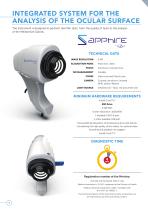
INTEGRATED SYSTEM FOR THE ANALYSIS OF THE OCULAR SURFACE The instrument is designed to perform tear film tests, from the quality of tears to the analysis of the Meibomian Glands. TECHNICAL DATA IMAGE RESOLUTION ACQUISITION MODE Multi shot, video Autofocus, manual focus ISO MANAGEMENT Variable CONES CAMERA LIGHT SOURCE Main cone and Placid cone Colored, sensitive to infrared (NIR), yellow-filtered Infrared LED – Blue, red and white LED MINIMUM HARDWARE REQUIREMENTS Intel® Core™ i7 SSD Drive 8 GB RAM Screen resolution: 1600x900 1 available USB 3.0 port 1 other available USB port Microsoft®...
Open the catalog to page 2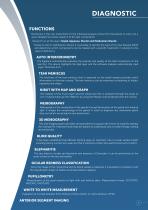
DIAGNOSTIC FUNCTIONS The Device is the new instrument for the individual analysis of tear film that allows to carry out a quick detailed structural research of the tear composition. Research on all the layers (Lipid, Aqueous, Mucin) and Meibomian Glands. Thanks to the Us Ophthalmic Device it is possible to identify the type of Dry Eye Disease (DED) and determine which components can be treated with a specific treatment, in relation to the type of deficiency. AUTO INTERFEROMETRY The Sapphire automatically evaluates the quantity and quality of the lipid component on the tear film. The device...
Open the catalog to page 3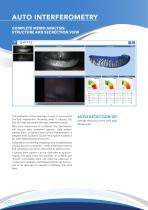
AUTO INTERFEROMETRY COMPLETE MEIBO ANALYSIS: STRUCTURE AND SECRECTION VIEW The evaluation of the lipid layer is part of your overall Dry Eye Assessment. Knowing what is causing Dry Eye will help determine the best treatment option. After your assessment is complete, the Optometrist will discuss your treatment options. Lipid pattern classification, incidence and clinical interpretation is adapted from Guillon & Guillon description incidence (%) with estimated thickness (nm). Observation of blinking frequency and completeness should also be considered - while listening to history and symptoms...
Open the catalog to page 4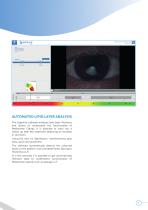
AUTOMATED LIPID LAYER ANALYSIS The Sapphire software analyses lipid layer thickness and allows to understand the functionality of Meibomian Glands. It is possible to carry out a follow up after MG treatment detecting an increase in secretion. Using the new Us Ophthalmic, Interferometry gets easy, quick and automatic. The software automatically detects the coloured lipids on the patient’s eye and determines lipid layer thickness (LLT). In a few seconds it is possible to get automatically relevant data to understand functionality of Meibomian Glands such as average LLT.
Open the catalog to page 5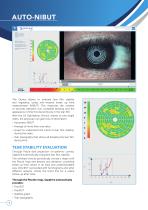
The Device allows to evaluate tear film stability and regularity, using non-invasive break up time measurement (NIBUT). This measures the number of seconds between one complete blinking and the appearance of the first discontinuity in the tear film. With the US Ophthalmic Device, thanks to one single video, the physician can gain lots of information: • Automatic NIBUT • Average of more than one value • Graph to understand the trend of tear film stability during the video • Tear topography that shows all breaking the tear film during time. TEAR STABILITY EVALUATION Through Placid disk...
Open the catalog to page 6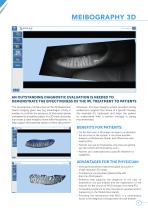
AN OUTSTANDING DIAGNOSTIC EVALUATION IS NEEDED TO DEMONSTRATE THE EFFECTIVENESS OF THE IPL TREATMENT TO PATIENTS The revolutionary introduction of the 3D Meibomian Gland imaging gives two big advantages. Firstly, it enables to confirm the presence of abnormal glands compared to a healthy subject in a 3D view; secondly, it provides a clear image to share with the patients, to help explain the potential reason of their discomfort. Moreover, this new imaging system provides strong evidence to support the choice of a specific therapy (for example IPL treatment) and helps the patient to...
Open the catalog to page 7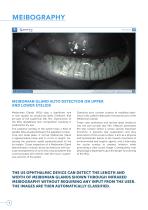
MEIBOMIAN GLAND AUTO DETECTION ON UPPER AND LOWER EYELIDS Meibomian Glands (MGs) play a significant role in tear quality by producing lipids (meibum) that are part of the superficial tear film. Dysfunction of the MGs destabilizes tear composition resulting in evaporative dry eye. The posterior lamella of the eyelid hosts a fleet of parallel MGs situated between the palpebral conjunctiva and tarsal plate. A normal Meibomian Gland is approximately linear and 3–4 mm in length, traversing the posterior eyelid perpendicularly to the lid margin. Closer inspection of a Meibomian Gland demonstrates...
Open the catalog to page 8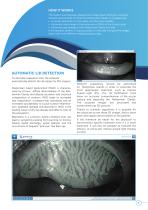
HOW IT WORKS The System automatically analyses the images taken through a sensitive infrared camera (NIR) to locate the Meibomian Glands in a guided way: • An exam valid both for the upper and the lower eyelids; • Automatic percentage of the extension of MGs in the chosen area • Automatic percentage of the Meibomian Gland loss area If the operator prefers, it is also possible to manually compare the images taken with three different related grading scales. AUTOMATIC LID DETECTION To decrease evaluation time, the software automatically detects the lid margin for MG analysis. Meibomian Gland...
Open the catalog to page 9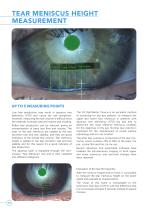
TEAR MENISCUS HEIGHT MEASUREMENT UP TO 5 MEASURING POINTS Low tear production may result in aqueous tear deficiency (ATD) and cause dry eye symptoms. However, measuring the tear volume is difficult since the methods normally used are invasive and irritating. Reflex tear production can be induced, giving an overestimation of basal tear flow and volume. The sizes of the tear meniscus are related to the tear secretion rate and tear stability, and they are good indicators of the overall tear volume. Tear meniscus height is related to the tear secretion rate and tear stability and for this...
Open the catalog to page 10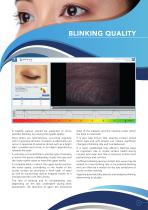
BLINKING QUALITY A healthy person should be expected to show periodic blinking, by closing the eyelids briefly. state of the subjects and the method under which the blink is measured. Most blinks are spontaneous, occurring regularly with no external stimulus. However, a reflex blink can occur in response to external stimuli such as a bright light, a sudden loud noise, or an object approaching towards the eyes. It is also well known that wearing contact lenses (both rigid and soft lenses) can induce significant changes in blinking rate and completeness. A voluntary or forced blink is another...
Open the catalog to page 11All US Ophthalmic catalogs and technical brochures
-
EFC-2600
8 Pages
-
LRK-7800
8 Pages
-
Auto Ref/Keratometer HRK-1
4 Pages
-
BINOCULAR MOBILE REFRACTOMETER
12 Pages
-
Surgical Camera System
2 Pages
-
Binocular Loupes
3 Pages













